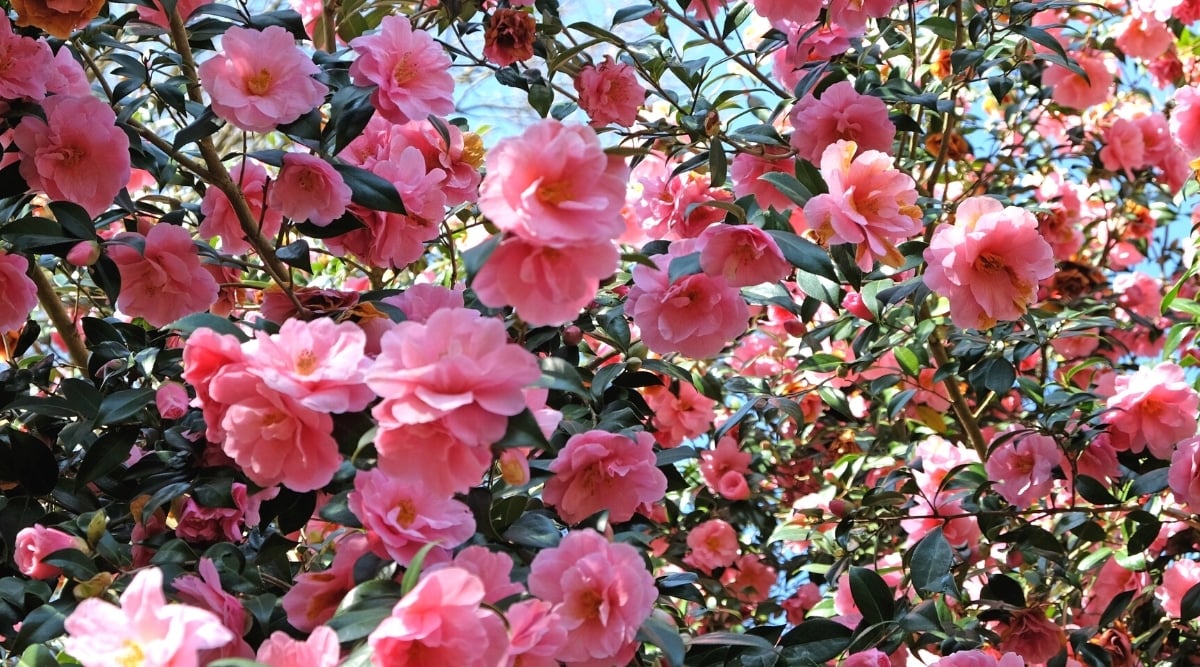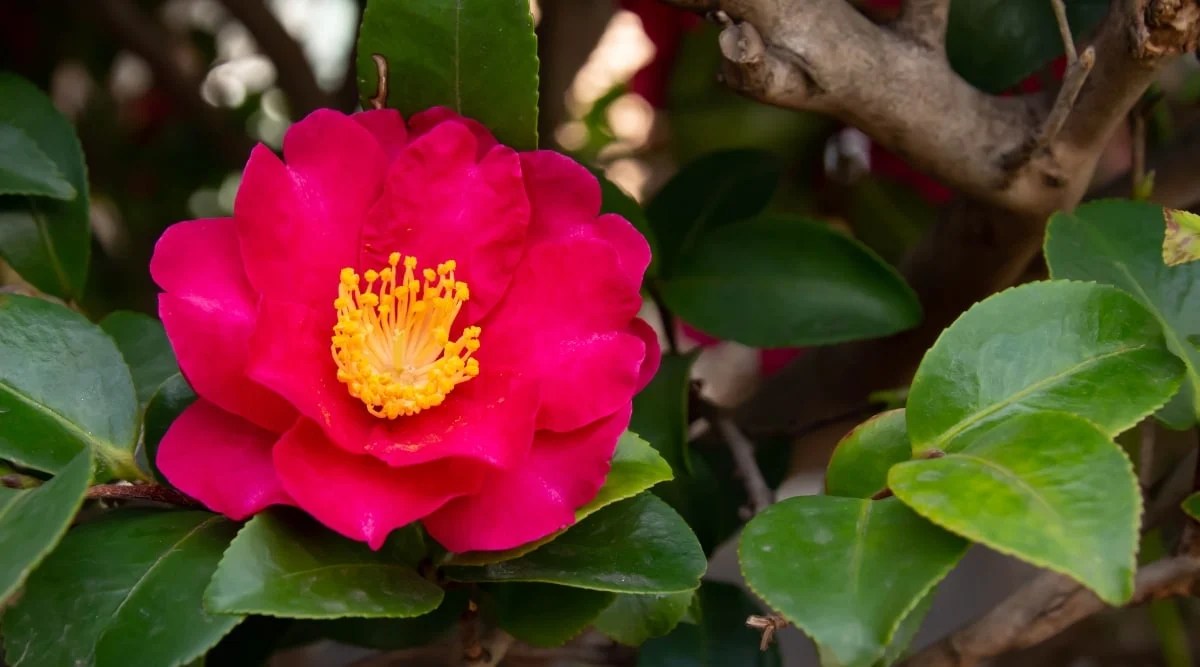Contents
There are two popular species of camellias that are commonly grown for ornamental purposes, so we are going to focus on those for the purposes of this article. Where you plant a camellia in relationship to the sun is very important in terms of maximizing flower production.
I describe the ideal light situation for a camellia as dappled sun. Think about the way light filters through a live oak canopy, with camellias planted underneath the oak. In the summer, when camellias are not in bloom, the sun is more intense, but the overhead trees have their leaves so the amount of light camellias get is greatly reduced by the density of the foliage overhead.
When the cooler months come around, the oaks drop their leaves, increasing the amount of light that gets in. Since the days are shorter and the sun is less intense in the winter, this makes for an ideal amount of filter, year-round. When oak trees drop their leaves, they make great mulch for the acid loving camellia, helping to enrich and acidify the soil.
Of course, not every gardener who wishes to grow camellias lives under an oak canopy, so here we will talk about these two species, c. Japonica and c. Sasanqua, and determine the best spot for them in any garden landscape.
The Short Answer
Japonica camellias grow best in dappled sunlight. A few hours of morning sun won’t hurt, but they produce more flowers if they have filtered sunlight throughout the day.
Sasanqua camellias prefer a bit more sun, and some even tolerate full sun. A mix of sun and shade will keep these camellias looking their best. Morning sun is better than hot afternoon sun to avoid scalding the leaves and flowers.
The Long Answer
To best understand the light needs for a particular plant, we need to first understand the different terms used for describing the different amounts of sunlight. The main categories by which amounts of sun and shade are described are Full sun, part sun, part shade, full shade and dappled or filtered sun.
Full Sun

Full sun is categorized as 6 or more hours of direct sunlight per day. If there are not many mature trees in your yard and the surrounding area, there is a good chance this applies to your space. Some plants that call for full sun need about 6-8 hours of direct sunlight per day, while others, such as some vegetables, need close to 10 hours per day.
Observe your yard between the hours of 10 a.m. and 5 p.m. The areas of your yard that have continuous sun exposure during these hours, or any 6-hour period during this time, are considered full sun.
Part Sun/Part Shade

Part sun, also referred to as part shade, is defined as 3-6 hours of direct sunlight per day. These hours do not have to be consecutive. If the space gets a few hours in the morning and a few hours later in the day, but is predominantly shaded during the afternoon hours, this qualifies as part sun.
The time of day when an area receives sun is as much a factor as for how long. Morning sun is less intense than afternoon sun. If your area receives 5 hours of hot afternoons sun, this would be closer to full sun than, say, a spot that receives 5 hours of sun in the morning. Afternoon sun is hotter and more intense.
Full Shade/Dappled Light

These terms are more or less interchangeable as well. Full shade is defined as fewer than 3 hours of sun per day, and typically early morning, or late afternoon sun. The term dappled sun refers to an area that receives light filtered through overhead trees, creating a pattern of spots of sun and of shade.
All plants need some sunlight to create photosynthesis, so even those considered to grow in full shade will need some sunlight, although these plants prefer not to receive direct sunlight. The term filtered sun is another way to describe this type of light.
Full Sun Sasanqua Camellias

Sasanqua camellias are hardy and easy to grow in zones 7-9. They tend to have a shorter, shrubbier growth habit than their japonica cousins.
They have a strong root system, which commonly lends to their use in grafting. It is not uncommon for a japonica to be grafted onto the root system of a sasanqua to bolster its ability to combat root diseases. Sasanquas are early bloomers, with most varieties beginning to bloom in mid fall.
Not only do sasanquas have hardy root systems, but their foliage is also able to tolerate more sun exposure than most camellia species, as well. With some varieties able to tolerate full sun, sasanquas are a great choice if your yard doesn’t have many mature trees to shelter them from the harsh afternoon sun.
Here are some varieties of sasanqua that can be grown in full sun. Remember that full sun is anything over 6 hours per day. 6 hours is about right for these varieties, much more than that and the plant will likely survive but is unlikely to produce many flowers.
‘Crimson N’ Clover’

Scientific Name: c. Sasanqua October Magic ‘Crimson N’ Clover’
- Plant Type: Evergreen
- Plant Size: 10’ tall and 7’ wide
- Sun Exposure: Full Sun to Full Shade
- Plant Zone: 7-9
This stunning camellia is a brilliant crimson color as its name states. Flowers are single petal formation with a dense cluster of gold tipped pink stamens in the center.
Crimson is a fast grower and blooms for up to 8 weeks. New growth appears with a hint of red, making this a colorful stunner year-round.
‘Alabama Beauty’

Scientific Name: c. Sasanqua ‘Alabama Beauty’
- Plant Type: Evergreen
- Plant Size: 12’-15’ tall and 6’-8’ wide
- Sun Exposure: Full Sun to Part Shade
- Plant Zone: 7-9
‘Alabama Beauty‘ makes a wonderful privacy hedge with its dense, deep green foliage. This is one of the earliest blooming camellias. Blooms on this camellia can be light pink to rose red and semi double petal formation. The ruffled inner petals allow glowing stamens to peek through partially obscured.
Shade-Friendly Japonica Camellias

The japonica species of camellia is greatly appreciated for its graceful treelike growth. Japonicas tend to grow taller than their sasanqua counterparts, but they tolerate far less direct sun, preferring to live in that dappled sunlight, or full shade.
Some varieties can handle a location with part sun, once mature, but they will produce the greatest number of flowers when they have plenty of shade, especially in the afternoon.
The Japonica species has a later blooming habit, making them popular because they tend to be the focal point in a winter landscape when few, if any, other flowering plants are producing blooms. They are a favorite way to entice pollinators out of hiding in the colder months with their abundance of protein rich pollen.
If you have a shaded area where you want to plant a camellia, here are two beautiful varieties of c. Japonica that do well in full shade and one that likes partial shade.
‘Fairy Blush’

Scientific Name: c. Japonica ‘Fairy Blush’
- Plant Type: Evergreen
- Plant Size: 4’-5’ tall and wide
- Sun Exposure: Filtered Light to Full Shade
- Plant Zone: 7-10
This wonderfully fragrant camellia has a delicate appearance. Deep pink buds open to reveal dainty pale pink to white, single petal form blooms. A large cluster of fully visible yellow stamens grace the center of these lovely flowers. The blooms resemble large apple blossoms.
This variety is small and makes a wonderful container plant. It’s nice to have in or near your outdoor living space as the fragrance truly needs to be enjoyed!
‘Jacks’

Scientific Name: c. Japonica ‘Jacks’
- Plant Type: Evergreen
- Plant Size: 6’-10’ tall and 4’-8’ wide
- Sun Exposure: Full shade to Part Sun
- Plant Zone: 7-9
Jacks is a beautiful spring bloomer. This upright grower boasts medium to large, formal double petal blooms that are as pretty as a picture. The flowers are rose red with neatly organized petals and completely obscured stamens.
Glossy green foliage makes this a great hedge plant. Jacks likes to live in that perfect dappled sun area, but it can take a few hours of direct morning sun, and perhaps just a bit more when mature.
Final Thoughts
For most species of camellia, part sun/part shade is the rule of thumb. While sasanquas tend to fare better than japonicas with a few extra hours of direct sun, they will all reach their best blooming potential when planted in bright filtered light, away from the hot afternoon sun.